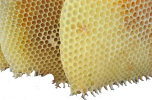 Bee wax is a dense substance. After melting the combs, it becomes a homogeneous solid mass; its color depends on the color of the melted combs – it can be yellow, greenish, red, white and even black. The color of the combs depends to a certain extent on the type of pollen that young bees ate. Color and other qualities of commercial bee wax also depend on the method of its processing.
Bee wax is a dense substance. After melting the combs, it becomes a homogeneous solid mass; its color depends on the color of the melted combs – it can be yellow, greenish, red, white and even black. The color of the combs depends to a certain extent on the type of pollen that young bees ate. Color and other qualities of commercial bee wax also depend on the method of its processing.
Bee Wax Grades
- fresh honeycomb wax usually has an almost white or creamy color. This bee wax has the highest value;
- in apiary processed bee wax – is melted and pressed through press directly in the apiary; it is classified among the best grades;
- pressed bee wax – is processed industrially in mechanical or hydraulic presses; its quality depends on the type of raw materials and technical equipment;
- extracted bee wax – is obtained from raw materials by the method of gasoline extraction; it has an unpleasant smell, excessive softness, a significant admixture of fats and resins. Extracted bee wax is used for technical purposes;
- bleached bee wax – it is bleached in the sun, or with the help of chemicals. It is harder and more brittle and is used in the industry.
After processing bee wax is cleared of “impurities” – pollen, propolis, fragments of larvae, injured bees and random impurities. Ware, used for bee wax processing, should be chemically neutral (for e.g. enameled or stainless steel). The contact of bee wax with iron or cast iron gives it a brown color, contact with copper gives it greenish color.
The density of bee wax is 0.95-0.96 cm3, so it floats in water. At a temperature of 62-72 ° C, it becomes liquid, boils at a temperature above 100 ° C. It stiffens at a temperature of 60° C. It is impermeable to water, its qualities do not decrease either from heat, or from cold, or from light, or from dampness. The wax moths strike it only at a temperature of 30–40 ° C.
Bee wax is very resistant to the environment and well preserved for hundreds of years, almost without changing its properties. During long-term storage, a grayish-white film forms on its surface, which is a sign of the purity of the bee wax. This plaque disappears after bee wax is heated to a temperature of 35-40° C.
In water, bee wax is insoluble, in cold alcohol it is soluble but not easily, in boiling alcohol it is soluble easily. In addition, the bee wax is soluble in ether, acetone, chloroform, gasoline and turpentine, especially when heated.
The chemical composition of the bee wax is very complex; it contains up to 300 substances. It is based on esters (70 -75%), free fatty acids (13 -15%), saturated hydrocarbons (12-15%). Bee wax contains some water, aromatic and dyestuffs, mineral salts, antibiotic substances, a lot of carotene (there are no other vitamins). A large number of esters protect the bee wax from entering into chemical reactions with other substances besides alkalis. That is why bee wax can be preserved for hundreds of years.
It is possible to falsify bee wax. In such cases, the bee wax is mixed with paraffin, rosin, stearin and ceresin. These additives give the mixture a new quality, a new smell and taste. If the bee wax was falsified the cut will be shiny and smooth, it becomes more fragile and easily crumbled, when smearing a piece of such wax fat is felt, when chewing it sticks to the teeth, and it quickly sinks in water.
Humans has been using bee wax since ancient times. At the beginning it was used for candles and for embalming corpses. Later – for making dummies, busts, wax figures, gramophone records. Bee wax is still used in paints
